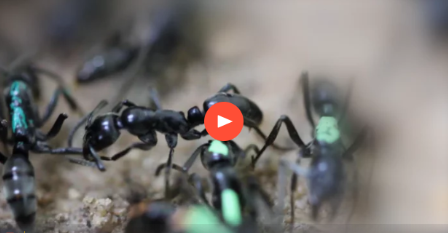http://3.bp.blogspot.com/-Xo6h5X1wyok/WoQlRUPXmyI/AAAAAAAAPAE/5D4UpnuWD_od8STMkgFZe1k5BZN4NilJQCK4BGAYYCw/s1600/2018-02-14_17-31-42.png

When the battle is done the victors head home, their march broken only to gather the wounded, who are hauled back to base for life-saving treatment.
Not a heroic scene from the second world war, but the daily grind for African Matabele ants, which leave their nests in the hundreds to launch raids on feeding termites – and risk life and limb in the process.
Researchers who study the ants have shown before that the social insects pick up their injured and carry them home. Now, the ants have been spotted caring for their casualties: cleaning their wounds and perhaps even administering antibiotics to fend off infections.
It is an unprecedented glimpse of nursing in nature, a programmed behaviour that significantly reduces deaths in the ant colony. “What we show, for first time in the animal kingdom, is a proper treatment focused on a wound,” said Erik Frank, a behavioural ecologist at the University of Wurzburg. “We have anecdotal observations of wound care in other animals, but none that have been studied scientifically.”
Matabele ants, or Megaponera analis, reach 2cm in length(0.8in) when fully grown, and feed on termites for breakfast, lunch and dinner. To find their next meal, the ants bypass the well-defended termite mounds and instead send scouts into the savannah to spot termites feeding on dead plant matter under the ground.
When a scout returns with a termite sighting, the ants prepare a raiding party of up to 600 individuals which head straight for the location. On arrival, the larger ants break through the overlying mud, while the smaller ants swarm in to kill their prey and carry the carcasses home.
The raids are rarely without casualties on the ant side. About a third of the smaller ants that take part in termite hunts lose a leg at some point, courtesy of the termites fighting back and nipping off their limbs. Many ants lose only a single leg, but others are maimed so badly they can no longer stand.
In three years of field experiments in the humid savannah woodland at Comoé National Park, Ivory Coast, the scientists watched more than 200 ant raids on termite feeding grounds. They noticed that ants returning from a hunt performed a swift triage on any casualties they encountered. If the injured had only one or two legs missing, they were picked up and carried home. But if their injuries were much worse, the ants were left behind.
To study the insects more closely, the researchers moved six colonies into artificial nests at the national park’s research lab. There, scientists captured remarkable footage of ants caring for others with missing limbs. “We don’t know if they are just removing dirt from the wound or applying an antimicrobial substance to fight off an infection. But we do know that if they don’t receive the treatment, 80% die within 24 hours. If you allow the treatment for an hour, the ants survive,” said Frank.
Injured ants call for help by sending out distress signals in the form of pheromones. When help arrives, the injured ants tuck in their legs so they can more easily be carried back to the nest. Frank showed that coating dead ants in pheromone summoned helpers, but the ants soon moved on when their fallen comrades failed to tuck into the right position.
The scientists believe a simple rule governs which damaged ants are saved in nature. After battle, the first priority of an injured ant is to stand up into a resting position. From here, it can release pheromones to call for help. “Heavily injured ants cannot get up again, they keep thrashing around, ignoring everything around them,” said Frank. As a result, the most severely injured either fail to call, or do not assume the right position to be carried home, and are left for dead. “It’s very simple, but it enables the ants to triage the injured. If you can stand up you are still useful,” said Frank, whose research appears in Proceedings of the Royal Society B.
“One of the fascinating things about ant society is you can get very complex and sophisticated behaviour without any need of cognition or knowledge of what you are doing,” Frank said.
guardian.co.uk © Guardian News & Media Limited 2010
Published via the Guardian News Feed plugin for WordPress.
'Paramedic ants' observed treating injured comradeshttps://goo.gl/wkhJ35











0 comments:
Post a Comment